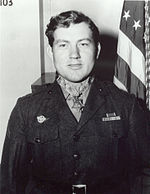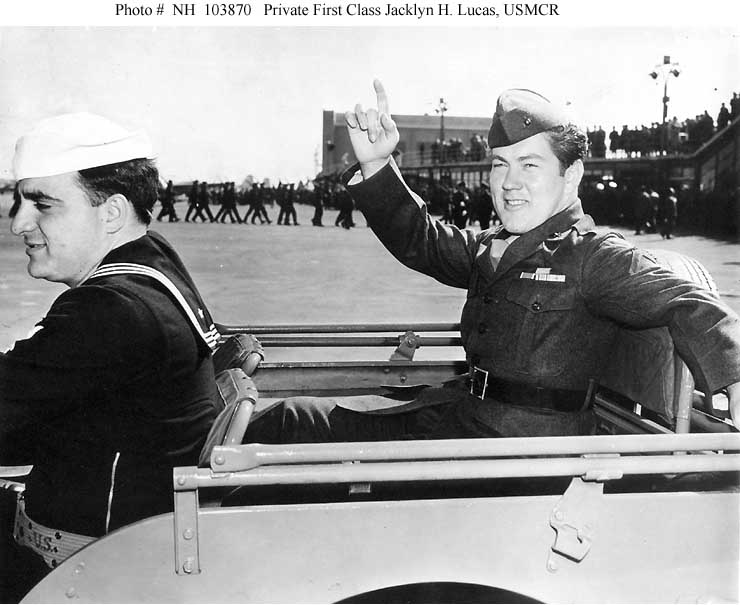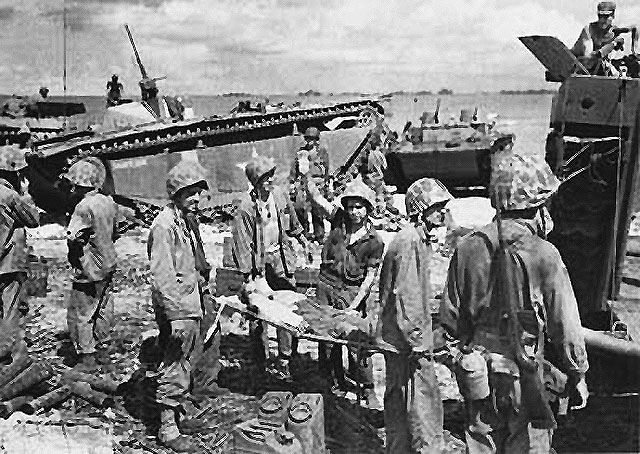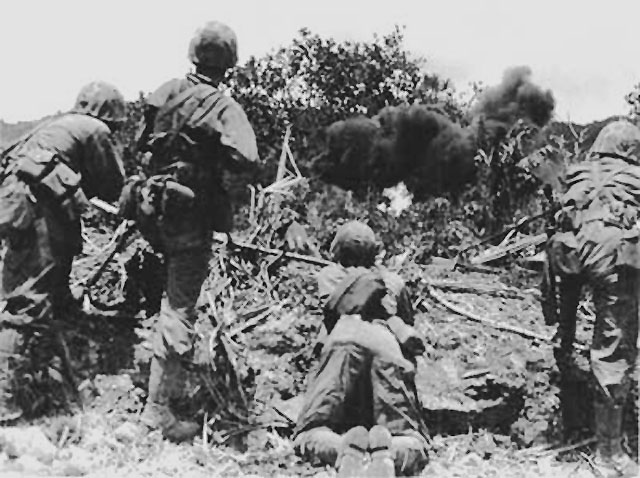During a close firefight in two trenches between Lucas and three Marines with 11 Japanese soldiers, Lucas saved the lives of the other three Marines from two enemy hand grenades that were thrown into their trench by unhesitatingly placing himself on one grenade, while in the next instant pulling the other grenade under him. The grenade he covered with his body exploded, and wounded him severely; the other grenade did not explode. He is the youngest Marine and the youngest serviceman in World War II to be awarded the United States' highest military decoration for valor. He later reenlisted in the United States Army and reached the rank of captain.
| Jacklyn Harold Lucas | |
|---|---|
  | |
| Nickname(s) | Jack |
| Born | February 14, 1928 Plymouth, North Carolina, U.S. |
| Died | June 5, 2008 (aged 80) Forrest General Hospital Hattiesburg, Mississippi, U.S. |
| Allegiance | |
| Service/branch | |
| Years of service | 1942–1945 (U.S. Marine Corps) 1961–1965 (U.S. Army) |
| Rank | Private first class (US Marine Corps) Captain (U.S. Army) |
| Unit | 1st Battalion, 26th Marine Regiment, 5th Marine Division 82nd Airborne Division |
| Battles/wars | -Battle of Iwo Jima |
| Awards | Medal of Honor Purple Heart Medal |
He was only 14 years old, but had a muscular build, was 1.73 m tall, and weighed 82 kg, when he enlisted in the Marine Corps Reserve at Norfolk, Virginia[4] without his mother's consent on August 8, 1942. He gave his age as 17 and forged his mother's name, and was sent to Marine Corps Recruit Depot Parris Island, South Carolina, for recruit training. During his rifle qualification, he qualified as a sharpshooter.

He was next assigned to the Marine Barracks at Naval Air Station Jacksonville, Florida. In June 1943, he was transferred to the 21st Replacement Battalion at Marine Corps Air Station New River, North Carolina, and one month later he went to the 25th Replacement Battalion, and successfully completed schooling at Camp Lejeune, North Carolina, which qualified him as a heavy machine gun crewman.[5] He was sent by train to San Diego with his unit. He left the continental United States on November 4, 1943, and the following month he joined the 6th Base Depot of the V Amphibious Corps at Pearl Harbor, Hawaii. On January 29, 1944, he was promoted to private first class.
On January 10, 1945, according to statements he made to his comrades, Lucas walked out of camp to join a combat organization wearing a khaki uniform and carrying his dungarees and field shoes in a roll under his arm. He was declared UA (Unauthorized Absence) when he failed to return that night, and a month later he was reduced to the rank of private. He stowed away on board the USS Deuel, which was transporting the 1st Battalion, 26th Marines of the 5th Marine Division to Iwo Jima.


On February 8, the day before he would have been placed on the Marine Corps "deserter list", he turned himself in to Marine Captain Robert Dunlap, Commanding Officer of C Company. He was taken by Captain Dunlap to the battalion's commanding officer, Lieutenant Colonel Daniel Pollock, and was assigned to Dunlap's rifle company as a rifleman. On February 14, Lucas had his 17th birthday while at sea five days before the invasion of Iwo Jima began.
On February 19, Lucas participated in the 5th Division's landing on Iwo Jima with C Company, 1st Battalion, 26th Marines. On February 20, Lucas and three Marines who were members of a four-man fire team from one of C Company's platoons were creeping through a twisting ravine towards or at an enemy airstrip when they spotted an enemy pillbox and got into a trench for cover. They then spotted 11 Japanese soldiers in a parallel trench (they had a tunnel to there from the pillbox) and opened up on them with rifle fire. The Japanese also opened fire and threw two grenades inside the Marines' trench in front of them.
Lucas spotted the grenades on the ground in front of his comrades and yelled "grenades". He then jumped over a Marine and dove for them, jamming one of them into the volcanic ash and soft sand with his rifle and covering it with his body, while reaching out and pulling the other one beneath him. One grenade exploded, tossing Lucas onto his back and severely wounding him in the right arm and wrist, right leg and thigh, and chest. He was still conscious and barely alive after the blast, holding in his left hand the other grenade, which did not explode. His three comrades were unharmed, and the Japanese soldiers in their trench were all killed; the three Marines left, believing Lucas was dead.


Lucas was found by Marines from another unit passing by who called for a navy corpsmen who attended to his wounds and protected him with a carbine from being shot and killed by a Japanese soldier in the trench. He was evacuated by stretcher bearers to the beach, onto an LST to a cargo ship used as a hospital (all the hospital ships were full) and then to the hospital ship Samaritan. He was treated at various field hospitals prior to his arrival in San Francisco, California on March 28, 1945. He eventually underwent 21 surgeries.
For the rest of his life, there remained about 200 pieces of metal, some the size of 22 caliber bullets, in his body — which set off airport metal detectors. In August, the mark of desertion was removed from his record while he was a patient at the U.S. Naval Hospital at Charleston, South Carolina. On September 18, he was discharged from the Marine Corps Reserve because of disability resulting from his wounds following his reappointment to the rank of private first class.

On October 5, 1945, Lucas, three sailors, and ten other Marines, including Robert Dunlap, his former company commanding officer on Iwo Jima, were presented the Medal of Honor by President Harry S. Truman during a ceremony on the South Lawn of the White House. Those in attendance at the ceremony included Lucas's mother and brother, Admiral Chester Nimitz, and Secretary of Defense James Forrestal.
Lucas earned a business degree from High Point University and was initiated into the Pi Kappa Alpha fraternity (Delta Omega Chapter). He joined the United States Army in 1961 and served in the 82nd Airborne Division as a paratrooper to conquer his fear of heights. He survived a training jump in which neither of his two parachutes opened. He volunteered for Vietnam, but was not allowed to go there and ended his time as a captain in 1965 at Fort Bragg, North Carolina, training troops for the Vietnam War.
When the keel of the USS Iwo Jima (LHD-7) (christened in 2000) was laid, Lucas placed his Medal of Honor citation in the ship's hull, where it remains sealed.
On August 3, 2006, Lucas, along with 15 other living Marine Medal of Honor recipients, was presented the Medal of Honor flag by Commandant of the Marine Corps General Michael Hagee at the Marine Barracks in Washington, D.C. in front of over 1,000 people, including family, friends, and Marines. Lucas said of the ceremony, "To have these young men here in our presence — it just rejuvenates this old heart of mine. I love the Corps even more knowing that my country is defended by such fine young people."
Lucas died at a hospital in Hattiesburg, Mississippi on June 5, 2008, of leukemia, with family and friends by his side.
On September 18, 2016, Secretary of the Navy Ray Mabus announced that an Arleigh Burke-class destroyer, DDG-125, would be named in honor of Lucas
A beautiful tribute...but 200 pieces of metal, incredible!! Great post, once again...
VastaaPoistaMoi, Phil.
PoistaThank you.
And yes. 200 shreds are very much even though they are small, 022 caliber.
I have never heard so many hits before.
The mass of these lots is much, within a man.
With time, the human's body pushes some iron and glass parts out of body, but not all.
I have seen men, (1950 - 1960) which has been taken / dig out, the large granate splinters.
The skin has been very thin and glassy, near to see men's inside
The sun does not catch and does not make the skin brown.
During a man's lifetime this will no longer change.